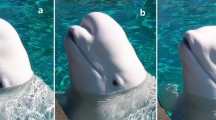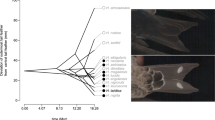Abstract
Many animals acquire otherwise inaccessible food with the aid of sticks and occasionally water. As an exception, some reports suggest that elephants manipulate breathing through their trunks to acquire inaccessible food. Here, we report on two female Asian elephants (Elephas maximus) in Kamine Zoo, Japan, who regularly blew to drive food within their reach. We experimentally investigated this behaviour by placing foods in inaccessible places. The elephants blew the food until it came within accessible range. Once the food was within range, the elephants were increasingly less likely to blow as the distance to the food became shorter. One subject manipulated her blowing duration based on food distance: longer when the food was distant. These results suggest that the elephants used their breath to achieve goals: that is, they used it not only to retrieve the food but also to fine-tune the food position for easy grasping. We also observed individual differences in the elephants’ aptitude for this technique, which altered the efficiency of food acquisition. Thus, we added a new example of spontaneous behaviour for achieving a goal in animals. The use of breath to drive food is probably unique to elephants, with their dexterous trunks and familiarity with manipulating the act of blowing, which is commonly employed for self-comfort and acoustic communication.



Similar content being viewed by others
References
Bates LA, Poole JH, Byrne RW (2008a) Elephant cognition. Curr Biol 18(13):544–546
Bates LA, Sayialel KN, Njiraini NW, Poole JH, Moss CJ, Byrne RW (2008b) African elephants have expectations about the locations of out-of-sight family members. Biol Lett 4(1):34–36
Beck BB (1980) Animal tool behaviour: the use and manufacture of tools by animals. Garland STPM Publishing, New York, p 10
Bekoff M, Dorr R (1976) Predation by ‘shooting’ in archer fish, Toxotes jaculatrix: accuracy and sequences. Bull Psychon Soc 7:167–168
Bentley-Condit VK, Smith EO (2010) Animal tool use: current definitions and an updated comprehensive catalog. Behaviour 147(2):185–221
Brown C (2012) Tool use in fishes. Fish Fish 13:105–115
Byrne RW, Bates LA, Moss CJ (2009) Elephant cognition in primate perspective. Comp Cogn Behav Rev 4:65–79
Chevalier-Skolnikoff S, Liska J (1993) Tool use by wild and captive elephants. Anim Behav 46:209–219
Darwin C (1874) The descent of man, and selection in relation to sex, 2nd edn. John Murray, London, p 76
Giudice AM, Pavé R (2007) Cebus paraguayanus in zoos: the spontaneous expression of species-specific behaviors. Neotrop Primates 14:65–71
Hart BL, Hart LA, McCoy M, Sarath CR (2001) Cognitive behaviour in Asian elephants: use and modification of branches for fly switching. Anim Behav 62(5):839–847
Irie N, Hasegawa T (2009) Elephant psychology: what we know and what we would like to know. Jpn Psychol Res 51(3):177–181
Irie-Sugimoto N, Kobayashi T, Sato T, Hasegawa T (2008) Evidence of means–end behavior in Asian elephants (Elephas maximus). Anim Cogn 11(2):359–365
Jesse E (1834) Gleanings in natural history, vol i. John Murray, London, p 19
Kuba MJ, Byrne RA, Burghardt GM (2010) A new method for studying problem solving and tool use in stingrays (Potamotrygon castexi). Anim Cogn 13(3):507–513
Leighton TG (2004) From seas to surgeries, from babbling brooks to baby scans: the acoustics of gas bubbles in liquids. Int J Mod Phys B 18(25):3267–3314
Lethmate J (1982) Tool-using skills of orang-utans. J Hum Evol 11(1):49–64
Maravita A, Iriki A (2004) Tools for the body (schema). Trends Cogn Sci 8(2):79–86
Martin P, Bateson P (1986) Measuring behaviour. Cambridge University Press, New York
Mendes N, Hanus D, Call J (2007) Raising the level: orangutans use water as a tool. Biol Lett 3:453–455
Nissani M (2004) Theory of mind and insight in chimpanzees, elephants, and other animals. In: Rogers LJ, Kaplan G (eds) Comparative vertebrate cognition: are primates superior to non-primates?. Kluwer/Plenum, New York, pp 227–261
Okanoya K, Tokimoto N, Kumazawa N, Hihara S, Iriki A (2008) Tool-use training in a species of rodent: the emergence of an optimal motor strategy and functional understanding. PLoS ONE 3(3):e1860
Olson D (ed) (2004) Ethogram of elephant behaviors. In Elephant husbandry resource guide. Allen Press, Lawrence, pp 103–121
Plotnik JM, Clayton NS (2015) Convergent cognitive evolution across animal taxa: comparisons of chimpanzees, corvids, and elephants. In: Margolis E, Laurence S (eds) The conceptual mind: new directions in the study of concepts. MIT Press, Cambridge, pp 29–55
Pollack D (1998) Spontaneous tool use in a vervet monkey (Cercopithecus aethiops sabaeus). Am J Primatol 45(2):201
Romanes GJ (1883) Animal intelligence. Kegan Paul Trench, London, p 398
Seed A, Byrne R (2010) Animal tool-use. Curr Biol 20(23):1032–1039
Shumaker RW, Walkup KR, Beck BB (2011) Animal tool behavior: the use and manufacture of tools by animals. JHU Press, Baltimore
Smet AF, Byrne RW (2014) Interpretation of human pointing by African elephants: generalisation and rationality. Anim Cogn 17(6):1365–1374
St Amant R, Horton TE (2008) Revisiting the definition of animal tool use. Anim Behav 75(4):1199–1208
Taylor AH, Elliffe D, Hunt GR, Gray RD (2010) Complex cognition and behavioral innovation in New Caledonian crows. Proc R Soc Lond B 277:2637–2643
Wickler W, Seibt U (1997) Aimed object-throwing by a Wild African elephant in an interspecific encounter. Ethology 103(5):365–368
Wiley D, Ware C, Bocconcelli A, Cholewiak D, Friedlaender A, Thompson M, Weinrich M (2011) Underwater components of humpback whale bubble-net feeding behaviour. Behaviour 148(5):575–602
Yamamoto C, Furuta K, Taki M, Morisaka T (2014) Captive bottlenose dolphins (Tursiops truncatus) spontaneously using water flow to manipulate objects. PLoS ONE 9(9):e107796
Acknowledgments
We are deeply grateful to the staff of Kamine Zoo—particularly the zoo director Mr. Nobutaka Namae, and the zoo keepers Mr. Isamu Ouchi, Mr. Satoshi Kimura, Mr. Kazuyuki Takahara, and Mr. Tabito Nakamoto—for their assistance with the experiment. We thank Dr. Motoomi Yamaguchi (SOKENDAI) for his help in calculating reliability. We also thank the following people for their advice on improving the manuscript: Dr. Hisashi Ohtsuki, Dr. Ai Kawamori, Mr. Masahito Morita, and Dr. Finlay Stewart (SOKENDAI); and Dr. Michio Nakamura (Wildlife Research Center of Kyoto University).
Author information
Authors and Affiliations
Corresponding author
Ethics declarations
Conflict of interest
The authors declare that they have no conflict of interest.
Ethical standard
This experiment was approved by the Research Ethics Committee of The Graduate University for Advanced Studies (2014A002) and by Kamine Zoo.
Electronic supplementary material
Below is the link to the electronic supplementary material.
Supplementary material 1 (MOV 47386 kb)
Rights and permissions
About this article
Cite this article
Mizuno, K., Irie, N., Hiraiwa-Hasegawa, M. et al. Asian elephants acquire inaccessible food by blowing. Anim Cogn 19, 215–222 (2016). https://doi.org/10.1007/s10071-015-0929-2
Received:
Revised:
Accepted:
Published:
Issue Date:
DOI: https://doi.org/10.1007/s10071-015-0929-2




